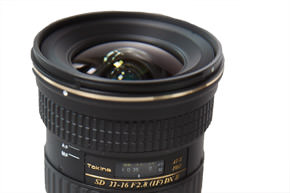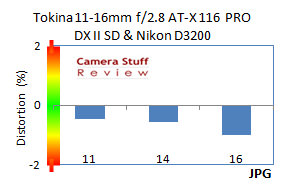At-x 116 Pro Dx-ii 11-16mm F/28 Lens for Nikon F Review
The original Tokina 11-xvi mm (Tokina 11-16mm f/2.8 AT-X 116 PRO DX II SD) had no built-in AF motor and has been for sale for a few years. Information technology is a fast, constant f/2.8 wide-angle zoom lens, designed for cameras with an APS-C / DX sensor. Some cheaper SLR cameras, such every bit the Nikon D3200 , have no congenital-in AF motor. It is especially for owners of these Nikon cameras that a new version of the Tokina 11-16 mm arrived on the market, equipped with a built-in AF motor. Apart from an additional nano-coating which reduces internal reflections, the lens remained unchanged. We tested the Tokina 11-16 mm DX 2 for yous, using a Nikon D3200 .


Structure and autofocusThere is cypher to criticize about the structure of the Tokina Pro series lenses. It does its Pro name honor. Both the zoom ring and the focus band take the right friction over the entire expanse. The bulldoze of the autofocus is very fast, only also conspicuously aural. There is little evidence of searching in depression low-cal, thanks to the high discontinuity of the Tokina 11-16 mm. The fashion you lot choose between autofocus and manual focus with Tokina AT-X lenses is hitting. This is done by means of a ring at the end of the lens, instead of a switch on the side of the lens, as with other brands. If yous pull out the band, the lens works through AF. If you pull this band towards yous, you can focus manually. Image stabilizationThe Tokina 11-xvi mm II has no congenital-in image stabilization. Given the abiding f/2.8 aperture and the focal length range of this lens, there will be very few situations where paradigm stabilization will be missed.Nikon D3200 lenscorrection: "Auto distortion control"When testing lenses, we effort to apply all bachelor in-camera lens correction for jpg files. Nikon cameras right chromatic aberration in jpg files (and do a adept chore, there), without offering a user the opportunity to exert influence on that process. You likewise have the option to correct (Nikon lens) jpg files for vignetting and distortion. To our anaesthesia we could too employ Auto distrtion control to the Tokina 11-16 mm Ii. In this review, the Nikon D3200 was set up to normal vignetting correction and auto distortion command for jpg files.
Image stabilizationThe Tokina 11-xvi mm II has no congenital-in image stabilization. Given the abiding f/2.8 aperture and the focal length range of this lens, there will be very few situations where paradigm stabilization will be missed.Nikon D3200 lenscorrection: "Auto distortion control"When testing lenses, we effort to apply all bachelor in-camera lens correction for jpg files. Nikon cameras right chromatic aberration in jpg files (and do a adept chore, there), without offering a user the opportunity to exert influence on that process. You likewise have the option to correct (Nikon lens) jpg files for vignetting and distortion. To our anaesthesia we could too employ Auto distrtion control to the Tokina 11-16 mm Ii. In this review, the Nikon D3200 was set up to normal vignetting correction and auto distortion command for jpg files.
For further details, see "unwanted correction of third political party lenses".
Vignetting Tokina 11-16mm DX II
For a wide-angle zoom lens, the corporeality of vignetting in jpg files is remarkably depression. Simply at f/2.eight, you lot can recognize vignetting in a shot of a very evenly illuminated surface, such as a blue sky. In the picture at the pinnacle of this page, you come across a worst case. Using software, this is piece of cake to correct. Using smaller aperttures, you will see no vignetting. Even without correction of vignetting are withal good performance for a wide angle zoom lens. Due to Nikon D3200's in-photographic camera correction of vignetting, the in-camera jpg files on average show a fourth stop less vignetting than the uncorrected RAW files. Simply, yous will see below that a Lightroom lens-correction profile works fifty-fifty meliorate.
Distortion Tokina 11-16 mm DX Two
Also in terms of baloney score the corrected jpg files of the Tokina 11-16mm very good. Only at a focal length of sixteen mm, the butt distortion merely visible. Comparison of the uncorrected RAW files to jpg files shows that the in-camera distortion correction of the Nikon D3200 good job at a focal length of 11mm, only the distortion is greater at a focal length of 14 to sixteen mm. The used lens correction contour is not intended for this Nikon lens. It is wiser to this parameter to plow off / to leave and instead utilise baloney correction in Lightroom or Photoshop.
Lightroom Lenscorrection

 The Lightroom lens correction contour is easy to use and very constructive. Below the Imatest results for vignetting at a focal length of 11mm f/two.8. After correction, the lite distribution over the entire image airplane is very evenly. From corner to corner, the largest difference in effulgence after Lens correction in Lightroom is e'er less than 0.25 stops. Individual lens corrections for Canon, Nikon and Sony mount Tokina 11-16mm lenses are available.
The Lightroom lens correction contour is easy to use and very constructive. Below the Imatest results for vignetting at a focal length of 11mm f/two.8. After correction, the lite distribution over the entire image airplane is very evenly. From corner to corner, the largest difference in effulgence after Lens correction in Lightroom is e'er less than 0.25 stops. Individual lens corrections for Canon, Nikon and Sony mount Tokina 11-16mm lenses are available.

Bokeh
Yous don't cull a wide angle lense for a nice bokeh. The Tokina 11-sixteen mm bokeh is not and so polish and conspicuously shows rings. The shape of the bokeh of a lite source in the background at full aperture is beautiful round. Equally presently every bit you start to stop downwardly this lens, that round bokeh changes from round to the shape of the discontinuity.
Flare
The Tokina 11-xvi mm is supplied with a lens hood. Just using such a wide angle lens information technology is not always possible to avoid a strong calorie-free shining straight into the lens. In such situations, flare and ghosting may occur, every bit is demonstrated in the image to the right. Light-green ghosting, equally we saw in the previous Tokina 11-16 mm test saw, nosotros are absent in the current test. Perchance that is the succes of to the extra nano blanket of the lens elements in the Tokina 11-16 mm DX II version.
Resolution Tokina 11-xvi mm 2 DX
The sharpness of the Tokina 11-16 mm is high. The sharpness in the middle is higher than in the corners. Yet that is not distracting: with more than 2000 lines per picture superlative (LW / PH), the sharpness in the corners is college than the center sharpness of a large number of lenses that we have previously tested.
Chromatic abnormality Tokina 11-16mm II DX
Thanks to the in-photographic camera correction of chromatic abnormality through the Nikon D3200 , in that location is no visible chromatic abnormality in the jpg files. In the RAW files at that place is visible chromatic aberration in the corners, as y'all tin can see in the 100% crop of an prototype, shown here. In Photoshop or Lightroom this tin can be resolved quickly. Use the standard Adobe lens correction profiles Adoobe, so you exercise not need to right each private file.
Decision Review Tokina 11-16mm Ii
Pro
- Loftier optical quality: very high center resolution
- Fast, constant f/ii.8 aperture
- Big field of view on a camera with an APS-C sensor
Cons
- No born image stabilization
- Sharpness in the corners is high indeed, but lower than the center sharpness
This Tokina 11-xvi mm Two review has a few pocket-size differences in comparison with our review of its predecessor: the Tokina xi-sixteen mm. The primary change is that the new version is equipped with a built-in AF motor. The extra nanocoating has led to a reduction of ghosting confronting strong backlighting. Given the constant f/2.viii discontinuity and the focal length range of this lens, the absence of a built-in image stabilization will exist rarely missed.
To our surprise, it is possible to correct vignetting and baloney in jpg file saved on the Nikon D3200 with Tokina 11-16 mm II. Cheers to the in-camera correction of vignetting, the performance of this lens becomes even better. But it is wise to exit this in-camera lens correction off. You lot'll become even beteer results using standard lens-profile distortion correction of RAW files in Lightroom or Photoshop.If you compare the optical performance of these lenses in our Tokina 11-16mm review with that of the Tokina 11-16mm DX II review, there's no pregnant difference between these two very well performing lenses. When you don't need the congenital-in AF motor, and so the old Tokina eleven-16 mm is a good, slightly cheaper, alternative for this splendid lens.
Field of view Tokina 11-xvi mm Ii @ 16 mm with and without correction of vignetting and distortion (using the lens profile for the Tokina 11-16mm version without congenital-in AF motor) by Lightroom. The Tokina 11-16mm 2 is designed for cameras with a DX / APS-C sensor, offering a field of view equal to the field of view of a xviii-26 mm zoom lens on a camera with a total frame sensor. The combination of a abiding f/2.8 aperture and the broad field of view make the Tokina 11-xvi mm DX II an exceptional lens.
hollinworthkone1963.blogspot.com
Source: https://camerastuffreview.com/en/tokina-11-16mm-ii-review/